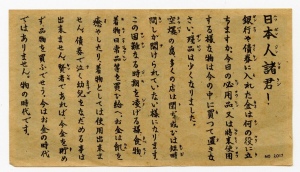March 9, 1974 in Lubang, Phillippines…
Retired Major Yoshimi Taniguchi of the Japanese Imperial Army flew to Lubang to officially relieve Second Lieutenant Hiroo Onoda of his duties and encourage his surrender to President of the Philippines, Ferdinand E. Marcos.
Hiroo had been sent to Lubang to fight in 1944. In September of 1945, after the bombings of Hiroshima and Nagasaki, Japan surrendered and World War II came to an end. Hiroo had no idea and he just kept fighting. He continued to fight for 29 more years.

Hiroo was born March 19, 1922. His family were samurai. His father also fought in WW2. In 1943, Hiroo’s father was killed in action in China.
Hiroo enlisted in the army at 18 years old and was trained as an intelligence officer. He left for Lubang on December 26, 1944.
His job was to keep the Americans off the island at all costs. This included bombing the airstrip on which he landed and destroying the pier. His orders stated that suicide or surrender was not an option. Hiroo’s commander told him that he may be there for a year or 10 years, but the army would come back for him.

The United States and Philippine forces took the island in March 1945 and almost all of the Japanese soldiers were killed or surrendered.
Hiroo took command of 3 men still on the island. They headed for the hills.
Hiroo (who had been promoted to lieutenant), Private Yūichi Akatsu, Corporal Shōichi Shimada and Private First Class Kinshichi Kozuka survived on bananas and coconuts. They also stole cows and rice from local farms.
The men built shelter out of bamboo. The heat was stifling. Rats and mosquitoes tormented the men day and night.
In October 1945, the men found a leaflet. It said that the war was over and ordered the men to leave the mountains. Hiroo was unsure. He and the men decided that it had come from the Americans. They stayed where they were, attacking anyone that came near them.

Later that year, more leaflets were dropped. General Tomoyuki Yamashita ordered any Japanese military men still in the mountains to surrender to the Philippine government. The men had gone into the mountains with orders to never surrender. Again, they refused to believe the war was over.
After living in the mountains for 4 years, Yūichi had had enough. He walked away from the group. He got lost and it took him 6 months to get to the base of the mountain. He surrendered.
The army, along with family and friends of the 3 remaining soldiers, dropped letters and pictures in 1952 urging the men to come out of the mountains. The men believed these to be fabricated.

In June 1953, Shōichi was shot in the leg by a fisherman from the area. With Hiroo’s help, he recovered.
A search party sent to look for the men accidentally killed Kinshichi on May 7, 1954.
Shōichi was killed in a shootout with police on October 19, 1972.
Hiroo was all alone in the mountains.
Norio Suzuki was a Japanese man that set out on a weird quest in 1974. He had heard about Hiroo and went out looking for him. Norio said that he wanted to find “‘Lieutenant Onoda, a wild panda and the Abominable Snowman, in that order.”
On February 20, 1974, he found Hiroo after only 4 days of searching.

The two men struck up a friendship and Norio asked Hiroo to come out of the mountains. Hiroo told him that he would only surrender if he received orders from his commanding officer. Norio took some pictures of himself and Hiroo to prove that he had found him, then set off to find Major Yoshimi.
Norio returned with Major Yoshimi who relieved Hiroo of his duties and ordered him out of the mountains.
In the 29 years that he had been living in the mountains, Hiroo had kept his rifle and uniform in remarkable shape. He relinquished his rifle, sword, ammunition, hand grenades and a dagger to President Ferdinand.

It is believed that Hiroo killed upwards of 30 people during his time in the mountains. Despite this, he was pardoned by the Filipino president. This enraged the people of Lubang.
After his surrender, Hiroo published an autobiography and moved to Brazil to raise cattle with his brother. He also got married.
Hiroo said that Japan had changed so much since he left that he didn’t recognize it. He felt that Japan had strayed away from traditional ideology and he didn’t like it.
Hiroo was offered a significant amount of back pay from the Japanese government, but he refused it. People began sending him money in appreciation for his service to Japan. He donated all of it to the Yasukuni Shrine.

Hiroo returned to Japan in 1984 and created the Onoda Nature School. This school trained students in survival skills that Hiroo learned and used living in the mountains.
Norio had found Hiroo. He also found a panda, but died in 1986 in the Himalayas looking for the Abominable Snowman.
In 1996, Hiroo returned to Lubang in order to donate $10,000 to the school there.
Hiroo died of pneumonia on January 16, 2014 in Tokyo, Japan. He was 91 years old.

A video summary of this week’s post can be found at
“Retired Major Yoshimi Taniguchi of the Japanese Imperial Army flew to Lubang to officially relieve Second Lieutenant Hiroo Onoda of his duties and encourage his surrender to President of the Philippines, Ferdinand E. Marcos.”
I wonder what would have happened if Taniguchi wasn’t alive – would Onoda have stayed on the island until he died?
LikeLiked by 1 person
I wondered that! I think so.
LikeLike